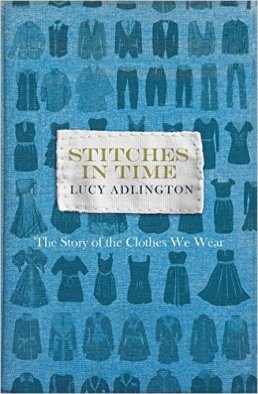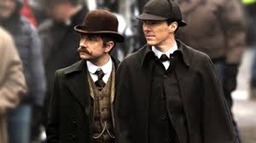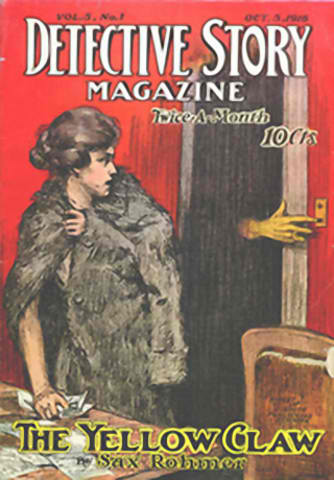Pulp-era Gumshoes and Queen Victoria’s Underwear: Stitches in Time: The Story of the Clothes We Wear by Lucy Addlington

Did you know that men used to wear falsies?
Not for their chests, but for their calves. Back in the 18th-century, men wore stockings and knee-britches, and if you didn’t have well-turned calf muscles, then you were a “spindle shank.” So some men with skinny legs wore little cushions.
Which leads us to the young soldier Jean-Roche Coignet, seduced by an older woman, thus beset by the excruciating problem of how to hide his “wretched false calves and… three pairs of stockings.” He managed to blow out the candle and stash them under the pillow. However, what was he going to do in the morning..?
That’s perhaps the raciest story in Stitches in Time: The Story of the Clothes We Wear, Lucy Addlington’s follow up to the exquisite Great War Fashion, but gives you a sense of how she laces the book with boots-on-the-ground anecdotes about living and loving in period costume. She also scatters it with quirky side notes. Did you know, for example, that there is a market for Queen Victoria’s underwear? I’ve very glad the publishers sent me a review copy.

Though it focuses on the 18th-20th century, treating earlier as backstory, this is not a guide to the complete ensemble for each period. Nor does it dwell on the minutia of style and construction — despite the title, this book is not for what historical reenactors call “stitching Nazis.”
Instead, each chapter tells the story of a particular garment: underwear, shirts, socks, corsets, dresses, trousers, coats, suits, ties, shoes, knitwear, pockets, swimming costumes, hats, accessories and pyjamas. By “story”, I mean the story of its development — including the influence of empire and revolution — its manufacture, how it was worn and by whom, and the experience of wearing it, or not — as in the case of poor Jean-Roche Coignet.
This book is worth reading for the shear pleasure of the lively narrative and amusing factoids (for example, bucket boots really did catch the rain and were often roomy enough for your slippers). It also has nice illustrations, though not on the lavish scale of Great War Fashion.
However, it is of particular interest to the Black Gate reader because it illuminates the books we read (and perhaps write).

It puts us in the shoes (and unmentionables) of the people we read about — the Pulp-era gumshoes and flappers, the Victorian Steam Punk inventors, the swashbuckling musketeers. They all feel a bit more real when we know how they dress in the morning, how they manage the call of nature, what fashion bloopers they worry about, how their clothes force them to walk or sit.
It also helps us decode some of the nuances. For example, men’s shirts were actually regarded as underwear until well past the Victorian period. If you took off your jacket, you’d immediately don a dressing gown. To be in your shirtsleeves was to be not entirely decent. The color of your shirt reflected your class and… and it’s a rabbit hole of nuance and snobbery. You just have to read it.
Finally, it’s a primer for Fantasy worldbuilders. It shows us just how… bizarro even comparatively “advanced” cultures can be about clothing. If corsets could be regarded as medicinal or health enhancing, if women could wear walking dresses in which you could not really walk, if men could wear calve-enhancers, if your social status could hinge on your cravat… well then just about anything is possible in a Fantasy setting, especially if the clothing reflects class and gender roles.
So, read Stitches in Time for pleasure and curiosity, but also so you can walk a mile in otherwhen’s shoes. If it only helps you better understand vintage fiction, it’ll still be worth it.
M Harold Page is the sword-wielding author of books like Swords vs Tanks (Charles Stross: “Holy ****!”) and is planning some more historical fiction. For his take on writing, read Storyteller Tools: Outline from vision to finished novel without losing the magic.
Thanks for this, it’s exactly the kind of thing that fascinates me, both as an 18th-century scholar, and as a fantasy writer. A couple of years ago the Bata Shoe Museum in Toronto had an exhibit of toxic clothing — shoes and dresses that had been died with arsenic and other poisons to create previously unseen colours. Apparently wearing such clothing was hazardous to the health. The exhibit was called, naturally, “Fashion to Die For”
You might want to have a look at A Gentleman’s Wardrobe: Classic Clothes for the Modern Man, Paul Keers. More 20th century, all male, but some really interesting anecdotes and historical observations.
I’ve been mugged by a short story set in the 1920s, so I suddenly need to know what my characters are wearing and how. You’ve probably saved me either three months or intermittent research or the kind of gaffes that make stories unsalable.
The Times Literary Supplement also gave it a glowing review. Tweet here: https://twitter.com/historywardrobe/status/697734647522967552/photo/1